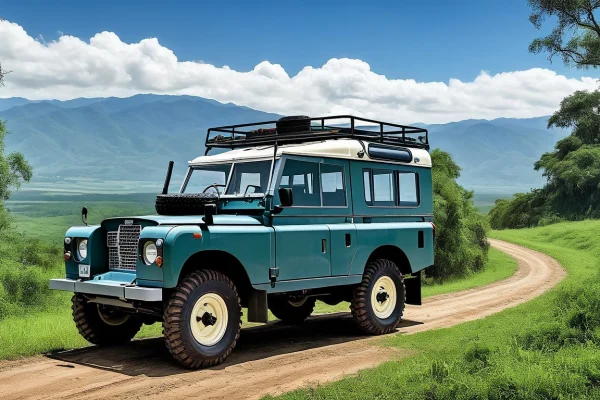Who Inspired the Creation of Land Rover?

- Who Inspired the Creation of Land Rover?
- The Birth of the Land Rover
- Key Figures in Land Rover's Development
- Maurice Wilks: The Visionary
- Wilks' Early Influences
- Wilks' Design Philosophy
- Collaboration and Innovation
- The Impact of World War II
- Military Vehicle Design Principles
- Post-War Adaptation
- Frequently Asked Questions
The creation of the Land Rover is not just a tale of engineering; it’s a story woven with the dreams and aspirations of those who dared to innovate. This iconic vehicle emerged from the rubble of post-war Britain, where the need for a versatile and rugged mode of transportation was paramount. The visionaries behind the Land Rover, particularly Maurice Wilks, were inspired by a combination of necessity, adventure, and a desire to create something that could traverse the most challenging terrains. But who exactly were these pioneers, and what drove them?
To understand the inspiration behind the Land Rover, we must first look at the historical context of its creation. In the aftermath of World War II, Britain was in dire need of practical solutions to mobility challenges. The landscape was dotted with remnants of war, and the demand for vehicles that could handle both agricultural tasks and leisure activities was growing. Thus, the Land Rover was born out of a vision that combined functionality with the spirit of adventure.
Key figures played pivotal roles in this journey. Here’s a brief look at the main inspirations:
| Influencer | Contribution |
|---|---|
| Maurice Wilks | Chief designer who prioritized off-road capabilities and versatility. |
| Spencer Wilks | Business strategist who supported the vehicle’s development and marketing. |
| Land Rover Team | Engineers and designers who collaborated to innovate and refine the vehicle. |
These individuals not only brought their skills to the table but also their personal experiences and backgrounds. For instance, Maurice Wilks had a deep understanding of engineering and a passion for off-road adventures. His experiences in the military during the war helped him to envision a vehicle that could withstand tough conditions while being accessible to everyday users.
In summary, the creation of the Land Rover was inspired by a unique blend of historical necessity, innovative thinking, and a collective vision for the future of transportation. This vehicle stands as a testament to the creativity and resilience of its creators, forever linked to the spirit of exploration and adventure.
The Birth of the Land Rover
In the aftermath of World War II, a time when the world was in desperate need of reconstruction and innovation, the Land Rover emerged as a beacon of hope and utility. The visionaries behind this iconic vehicle sought to create something that not only catered to the demands of a recovering society but also embodied the spirit of adventure and resilience. Imagine a rugged, reliable vehicle that could traverse the challenging terrains of the British countryside while also serving the practical needs of farmers, explorers, and everyday drivers alike. This was the dream that fueled the creation of the Land Rover.
At the heart of this endeavor was a team of passionate individuals, led by Maurice Wilks, who understood the importance of blending functionality with a touch of elegance. They envisioned a vehicle that would not only be robust but also versatile enough to adapt to various roles—from agricultural work to leisure activities. The design process was influenced by the pressing needs of the time, with many people looking for reliable transportation that could handle the rough and rugged landscapes.
| Key Factors in Land Rover’s Birth | Description |
|---|---|
| Post-War Demand | High need for durable vehicles for agriculture and transport. |
| Military Influence | Design principles derived from military vehicles enhanced durability. |
| Innovative Design | Focus on off-road capabilities and utility. |
As the team brainstormed, they drew inspiration from various sources. The simplicity of the Jeep, which had proven its worth during the war, was a significant influence. However, the Land Rover aimed to surpass that model by offering a more refined and versatile experience. This led to the incorporation of features such as:
- Four-Wheel Drive: Essential for navigating rough terrains.
- Durable Construction: Built to withstand harsh conditions.
- Spacious Interior: Designed for both passengers and cargo.
Ultimately, the birth of the Land Rover was not just about creating a vehicle; it was about encapsulating a lifestyle. It symbolized freedom, adventure, and the ability to tackle the great outdoors. With its launch in 1948, the Land Rover quickly became an icon, paving the way for future innovations in the automotive industry and inspiring countless enthusiasts around the globe.
Key Figures in Land Rover’s Development
The story of Land Rover is not just about a vehicle; it’s a tapestry woven with the threads of visionaries and innovators who dared to dream big. Among these influential figures, Maurice Wilks stands out as a pivotal character whose innovative ideas revolutionized the automotive landscape. His passion for off-road capabilities and his commitment to versatility directly influenced the design and functionality of the Land Rover, making it the iconic vehicle we know today.
Maurice Wilks, the chief designer at the time, was not just an engineer; he was a man with a vision. His journey began in the rugged landscapes of Wales, where he developed a deep appreciation for nature and adventure. This love for the outdoors fueled his ambition to create a vehicle that could traverse any terrain. Wilks believed that a vehicle should not only be practical but also inspire a sense of adventure. This philosophy became the backbone of Land Rover’s design.
| Key Figures | Contributions |
|---|---|
| Maurice Wilks | Chief designer, visionary behind off-road capabilities |
| Spencer Wilks | Managing director, supported production and marketing |
| Gordon Bashford | Engineering lead, focused on technical innovations |
But Wilks was not alone in his quest. He collaborated closely with his brother, Spencer Wilks, who played a crucial role in the vehicle’s production and marketing. Together, they formed a dynamic duo that brought the Land Rover to life. Their combined efforts led to groundbreaking innovations that set new standards for off-road vehicles. It’s fascinating to think about how their collaboration was like a well-tuned engine, each part working seamlessly to create something extraordinary.
In addition to the Wilks brothers, other key figures such as Gordon Bashford contributed significantly to the Land Rover’s development. Bashford’s engineering expertise ensured that the vehicle was not only rugged but also reliable. His commitment to quality helped establish Land Rover as a trusted name in the automotive industry.
In conclusion, the creation of the Land Rover was a collective effort, fueled by the passion and determination of its key figures. Their visionary ideas and collaborative spirit not only inspired the development of an iconic vehicle but also set the stage for a legacy that continues to thrive today. The Land Rover is more than just a car; it’s a symbol of adventure, resilience, and the innovative spirit of its creators.
Maurice Wilks: The Visionary
Maurice Wilks stands as a pivotal figure in the creation of the Land Rover, embodying the spirit of innovation and ruggedness that defines this iconic vehicle. His journey began in a post-war Britain that was in dire need of versatile transportation solutions. With a background in engineering, Wilks had a keen understanding of the challenges that lay ahead, not only for the automotive industry but also for a nation recovering from the aftermath of World War II.
Wilks’ vision was not born in isolation; it was influenced by a myriad of factors, including:
- His experiences with military vehicles during the war.
- The need for durable and functional vehicles in agriculture and industry.
- His passion for off-road adventures, which inspired the Land Rover’s design.
His design philosophy was simple yet profound: create a vehicle that could tackle any terrain while providing practicality for everyday use. This philosophy became the cornerstone of the Land Rover’s enduring legacy. Wilks believed that a vehicle should not only be robust but also adaptable to various environments and purposes. This approach led to the development of features like:
| Feature | Description |
|---|---|
| Four-Wheel Drive | Essential for off-road capability, allowing the vehicle to navigate rough terrains. |
| Durable Construction | Designed to withstand harsh conditions, ensuring longevity and reliability. |
| Versatile Design | Adaptable for various uses, from farming to leisure activities. |
Wilks’ early influences were instrumental in shaping his vision. He once stated, “The Land Rover was born out of necessity, a tool for the people, not just a luxury.” This quote encapsulates his belief that vehicles should serve a purpose beyond mere transportation. His relentless pursuit of innovation, combined with a deep understanding of user needs, laid the foundation for the Land Rover we know today.
In essence, Maurice Wilks was more than just a designer; he was a visionary whose contributions continue to resonate in the automotive world. His legacy is not only about the vehicle itself but also about the adventures and explorations it has enabled for countless individuals worldwide.
Wilks’ Early Influences
When we think about the Land Rover, it’s essential to understand the early influences that shaped Maurice Wilks, the mastermind behind its creation. Born into a family with a rich engineering background, Wilks was surrounded by innovation from a young age. His father was a prominent engineer, which sparked Wilks’ interest in mechanics and design. This early exposure to the world of engineering not only shaped his skills but also instilled a profound appreciation for functionality and durability.
Wilks’ journey into automotive design was further influenced by the tumultuous times of the Second World War. The war demanded vehicles that could withstand harsh conditions and perform reliably in diverse environments. This necessity for ruggedness became a cornerstone of Wilks’ design philosophy. He saw firsthand how military vehicles were constructed for extreme durability, and this inspired him to incorporate similar principles into the Land Rover.
In addition to his military experience, Wilks was also influenced by the agricultural community. After the war, farmers needed reliable vehicles to navigate rough terrains. This led him to envision a vehicle that could easily transition from the fields to the family driveway. The idea was not just to create a mode of transport but to design a vehicle that could adapt to various lifestyles.
| Influence | Description |
|---|---|
| Engineering Background | Wilks’ family had a strong engineering legacy, fostering his interest in mechanics. |
| Military Experience | Exposure to military vehicle design during WWII shaped his focus on durability. |
| Agricultural Needs | Understanding farmers’ requirements led to the vision of a versatile vehicle. |
In summary, Maurice Wilks’ early influences were a blend of family heritage, wartime experiences, and a keen understanding of civilian needs. These elements coalesced to inspire the creation of the Land Rover, a vehicle that would not only meet the demands of the time but also become an enduring symbol of adventure and exploration. Isn’t it fascinating how a few pivotal experiences can lead to the birth of an iconic brand?
Wilks’ Design Philosophy
Maurice Wilks, the chief designer behind the Land Rover, had a vision that transcended mere aesthetics; he aimed for utility and versatility. His design philosophy was deeply rooted in the practical needs of both farmers and adventurers, making the Land Rover a vehicle that could tackle the rugged terrains of the British countryside while also being a reliable companion for exploration. Imagine a Swiss Army knife on wheels—this was the essence of Wilks’ approach to design.
At the heart of Wilks’ philosophy was the belief that a vehicle should not only look good but also serve a purpose efficiently. He understood that post-war Britain was in dire need of a vehicle that could handle the harsh realities of rural life. This understanding led to several key design principles:
- Functionality: Every feature had to serve a specific purpose, whether it was the removable hardtop for versatility or the robust chassis for durability.
- Simplicity: Wilks favored straightforward designs that could be easily repaired, which was crucial in remote areas where specialized services were scarce.
- Adaptability: The Land Rover needed to perform well in various conditions, from muddy fields to rocky hills, making it a true all-terrain vehicle.
Wilks’ experiences during World War II played a significant role in shaping these principles. The military vehicles he worked on were engineered for maximum efficiency and resilience, lessons he applied to the Land Rover. In fact, the integration of military design principles can be seen in the vehicle’s robust frame and off-road capabilities, which were revolutionary at the time.
To illustrate the impact of Wilks’ design philosophy, consider the following table highlighting the key features and their intended benefits:
| Feature | Benefit |
|---|---|
| 4WD System | Enhanced traction on all terrains |
| Aluminum Body | Lightweight yet durable, preventing rust |
| Simple Controls | Ease of use for all drivers |
In conclusion, Maurice Wilks’ design philosophy not only inspired the creation of the Land Rover but also set a benchmark for future off-road vehicles. His commitment to functionality and adaptability ensured that the Land Rover would become an icon of adventure and exploration, resonating with those who sought to conquer the great outdoors.
Collaboration and Innovation
The journey of creating the Land Rover was not a solo endeavor; it was a remarkable tapestry woven from the ideas and efforts of many talented individuals. This collaboration among engineers, designers, and visionaries was crucial in transforming the Land Rover from a concept into a groundbreaking vehicle that set new standards for off-road performance. The synergy between these diverse minds led to innovations that not only enhanced the vehicle’s functionality but also solidified its place in automotive history.
At the heart of this collaboration was a shared vision: to create a vehicle that could tackle the harshest terrains while offering comfort and reliability. The team worked tirelessly, often brainstorming late into the night, fueled by a passion for innovation and a desire to push the boundaries of what was possible. Their collective efforts resulted in features that are now synonymous with the Land Rover brand, such as:
- Four-Wheel Drive System: Pioneering technology that provided unmatched traction and stability.
- Robust Chassis Design: Ensured durability and strength for rugged adventures.
- Versatile Body Styles: Adaptable for various uses, from farming to leisure.
One of the standout innovations was the introduction of the boxy design, which was not just a stylistic choice but a practical one. The shape allowed for easier manufacturing and maximized interior space, making it perfect for both utilitarian and recreational uses. This design philosophy was a direct result of the collaborative spirit that permeated the Land Rover development team.
Moreover, the integration of military vehicle design principles played a significant role in shaping the Land Rover’s capabilities. By incorporating lessons learned from military applications, the team was able to enhance the vehicle’s performance and durability. This blend of civilian and military engineering principles is a testament to the innovative mindset that drove the Land Rover’s creation.
In conclusion, the success of the Land Rover can be attributed to the powerful collaboration and innovation among its creators. Their ability to work together, share ideas, and push each other towards excellence resulted in a vehicle that not only met the demands of its time but also became an enduring symbol of adventure and exploration.
The Impact of World War II
World War II was a transformative period that not only altered the geopolitical landscape but also had a profound impact on automotive design, particularly for the Land Rover. The war created a pressing demand for vehicles that could withstand harsh conditions and navigate rugged terrains. This necessity directly influenced the Land Rover’s engineering, making it a symbol of resilience and adaptability.
During the war, military vehicles were designed with specific principles in mind, focusing on durability, versatility, and off-road capabilities. These principles were seamlessly integrated into the Land Rover’s design, ensuring it could handle the challenges of both military and civilian use. The ruggedness that became synonymous with the Land Rover was a direct result of the innovations developed during this tumultuous time.
| Military Design Principles | Description |
|---|---|
| Durability | Built to withstand rough handling and harsh environments. |
| Versatility | Adaptable for various roles, from transport to reconnaissance. |
| Off-Road Capability | Engineered to traverse difficult terrains, making it ideal for diverse conditions. |
After the war, the Land Rover evolved from a military vehicle to a civilian icon, appealing to adventurers and farmers alike. Its rugged charm and ability to tackle any terrain made it a beloved companion for those seeking exploration and adventure. The Land Rover quickly became a staple in various sectors, including agriculture, where its reliability and strength were highly valued.
As the world transitioned from war to peace, the Land Rover stood as a testament to human ingenuity and resilience. It not only represented the spirit of adventure but also symbolized the ability to adapt and thrive in changing circumstances. This adaptability continues to resonate with Land Rover enthusiasts today, making it a timeless vehicle that embodies the essence of exploration.
Military Vehicle Design Principles
The design of the Land Rover was profoundly influenced by , which were essential in shaping its functionality and durability. During World War II, vehicles were required to endure harsh conditions, navigate difficult terrains, and provide reliability under pressure. These principles didn’t just vanish after the war; instead, they became the backbone of the Land Rover’s identity. Imagine a vehicle that can traverse rocky paths, muddy fields, and sandy deserts with ease—that’s the essence of the Land Rover, rooted in military necessity.
One of the key principles was ruggedness. Military vehicles were built to withstand the rigors of battle, and this ethos carried over into the Land Rover’s design. The body was constructed from lightweight yet durable materials, allowing it to maintain strength without sacrificing agility. Furthermore, the vehicle’s suspension system was engineered to absorb shocks from uneven surfaces, making it a reliable companion for both military and civilian adventures.
| Design Principle | Description |
|---|---|
| Ruggedness | Built to endure harsh conditions and rough terrains. |
| Versatility | Adaptable for various roles, from military to civilian use. |
| Simplicity | Easy to repair and maintain in remote locations. |
Another critical principle was versatility. Military vehicles often served multiple purposes, and the Land Rover was no exception. It could be transformed into a troop carrier, a supply vehicle, or even an ambulance. This adaptability made it invaluable in various sectors, from agriculture to adventure tourism. Have you ever considered how a single vehicle can serve so many roles? That’s the magic of the Land Rover, a true chameleon of the automotive world.
Lastly, simplicity played a significant role in the design philosophy. Military vehicles were designed to be easily repaired in the field, and this principle was integrated into the Land Rover. Its straightforward engineering meant that even in remote locations, drivers could fix issues with minimal tools. This feature not only enhanced its appeal but also made it a favorite among explorers and adventurers.
In conclusion, the military vehicle design principles laid the groundwork for the Land Rover’s success. By combining ruggedness, versatility, and simplicity, the creators crafted a vehicle that not only met military needs but also captured the hearts of civilians seeking adventure. The legacy of these principles continues to thrive in every Land Rover on the road today.
Post-War Adaptation
After the dust settled from World War II, the world was in a state of flux, and so was the automotive industry. The Land Rover emerged as a beacon of hope and adventure, transforming from a military utility vehicle into a beloved symbol of exploration and versatility. This adaptation was not just a stroke of luck; it was a calculated response to the changing needs of society. With many returning soldiers eager to embrace the great outdoors, the Land Rover quickly became synonymous with adventure.
The rugged design and off-road capabilities that were initially developed for military purposes found a new life in civilian hands. Farmers, explorers, and even urban dwellers saw the potential of this versatile vehicle. The Land Rover was not simply a means of transportation; it became a lifestyle choice for those who sought freedom and adventure. Imagine the thrill of traversing rocky terrains or muddy fields, all while being comfortably seated in a robust vehicle that could handle it all!
To illustrate the various sectors where Land Rover found its niche, consider the following table:
| Sector | Uses |
|---|---|
| Agriculture | Transporting goods, navigating rough terrains |
| Exploration | Adventure trips, expeditions into uncharted territories |
| Leisure | Camping, off-roading adventures |
| Emergency Services | Rescue operations, remote area access |
As the Land Rover adapted to civilian needs, it also became a canvas for personal expression. Owners began customizing their vehicles, adding unique features to reflect their personalities and lifestyles. This trend not only solidified the Land Rover’s place in popular culture but also created a community of enthusiasts who shared a passion for adventure.
In the words of Maurice Wilks, “The Land Rover is not just a vehicle; it’s a companion for life’s journeys.” This sentiment encapsulates the essence of what the Land Rover represents—a trusty partner in exploration, whether you’re navigating through a muddy field or cruising down a scenic highway.
In conclusion, the post-war adaptation of the Land Rover was a masterclass in innovation and understanding consumer needs. It transformed from a military machine into a versatile vehicle that captured the hearts of many, proving that sometimes, the best ideas arise from the most unexpected circumstances.
Frequently Asked Questions
- What inspired the creation of the Land Rover?
The Land Rover was inspired by the need for a versatile vehicle that could handle rough terrains, especially after World War II. Its creators aimed to combine functionality with rugged design, catering to both military and civilian needs.
- Who were the key figures behind the Land Rover’s development?
The chief designer, Maurice Wilks, played a pivotal role in shaping the Land Rover. His innovative ideas and engineering background were crucial in developing the vehicle’s unique features, making it a beloved icon.
- How did World War II influence the Land Rover’s design?
World War II significantly impacted the Land Rover’s design, as military requirements emphasized durability and adaptability. The vehicle was crafted to meet the demands of wartime use, which later translated into its civilian applications.
- What design principles did Maurice Wilks prioritize?
Maurice Wilks focused on utility and versatility in his design philosophy. He believed that a vehicle should not only be robust but also functional for various purposes, which became a hallmark of the Land Rover’s enduring legacy.
- How did the Land Rover adapt for civilian use after the war?
After the war, the Land Rover transitioned to meet civilian needs by becoming a symbol of adventure. It found applications in agriculture, leisure, and exploration, appealing to those seeking ruggedness and reliability.





